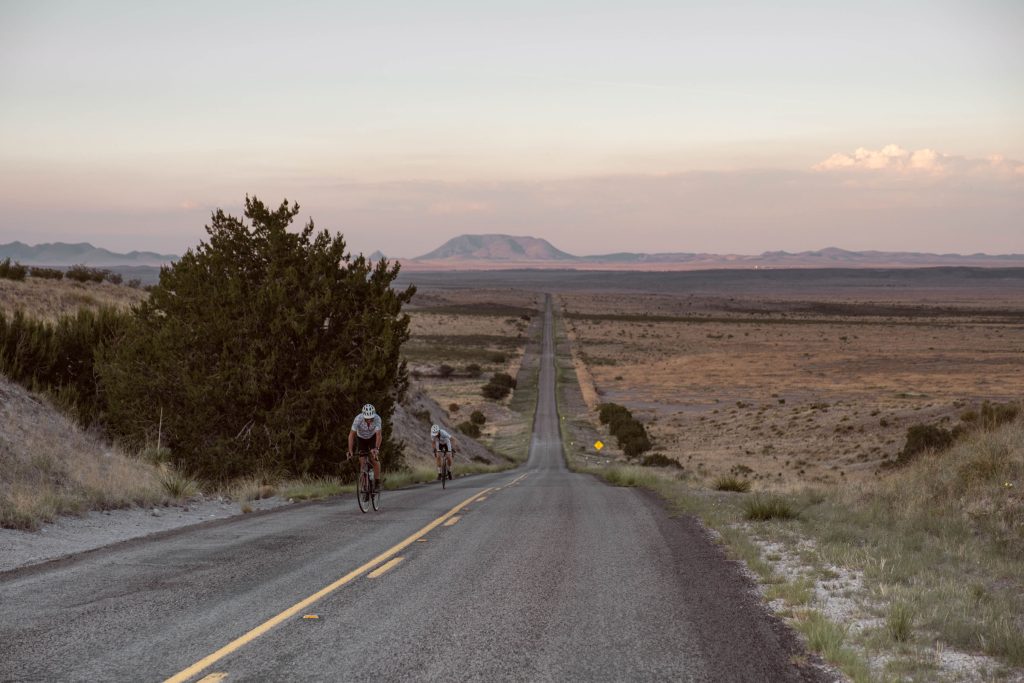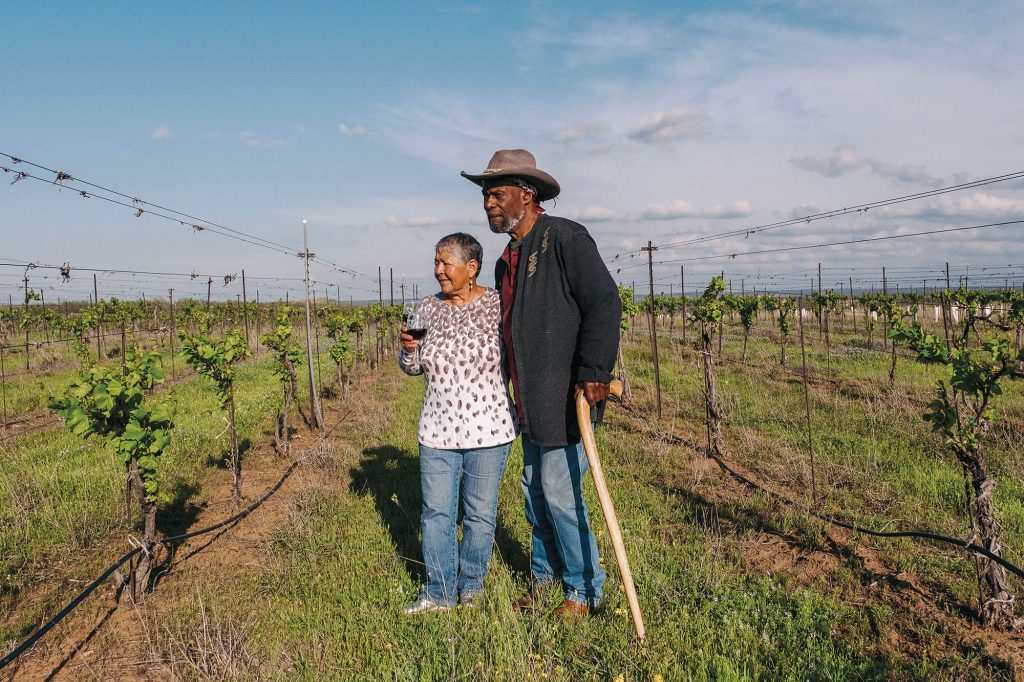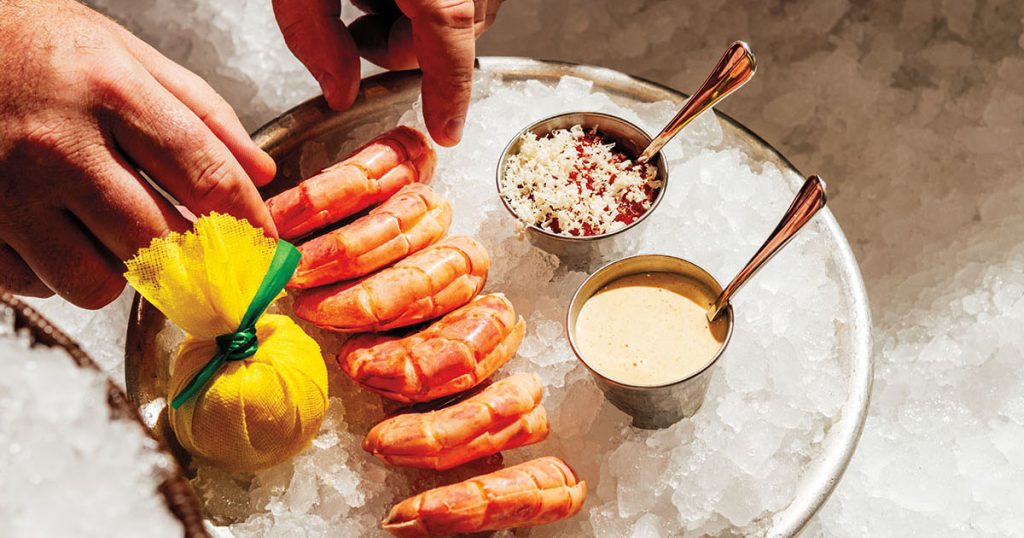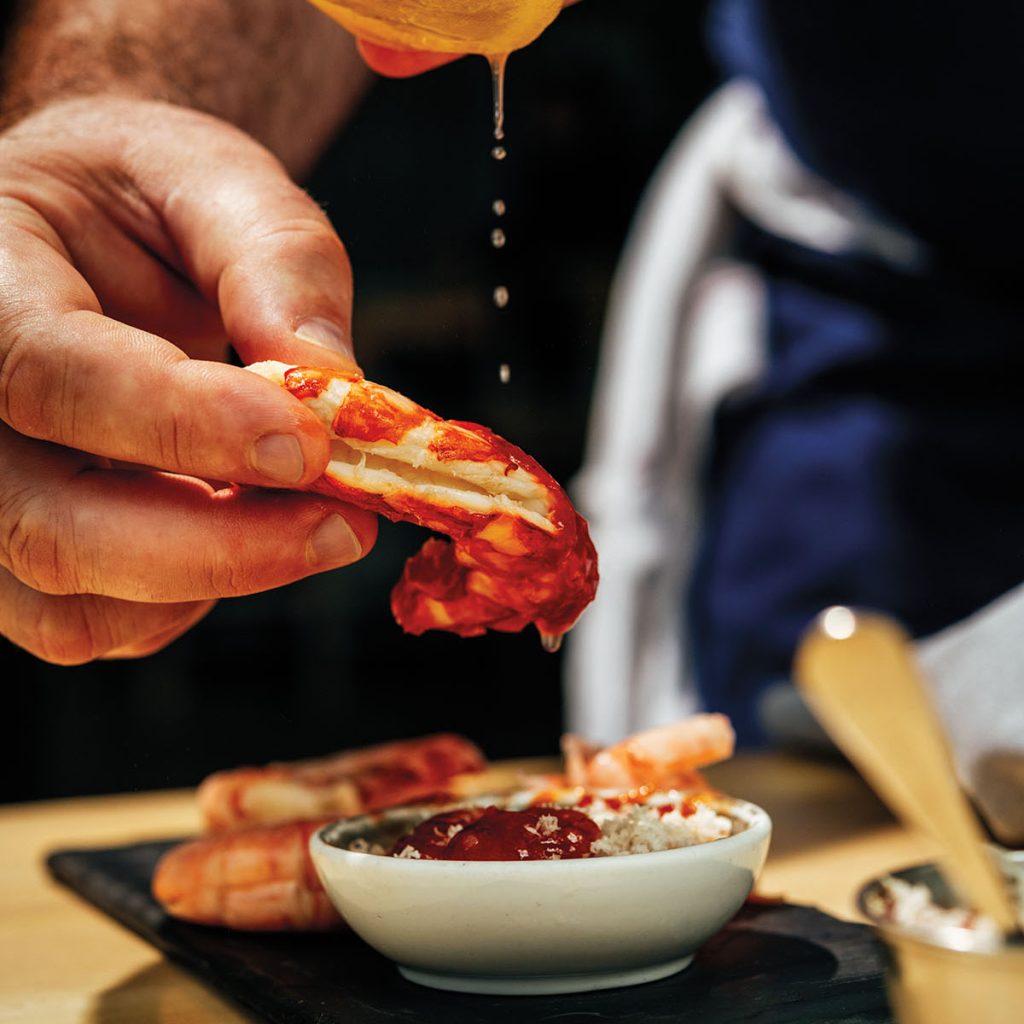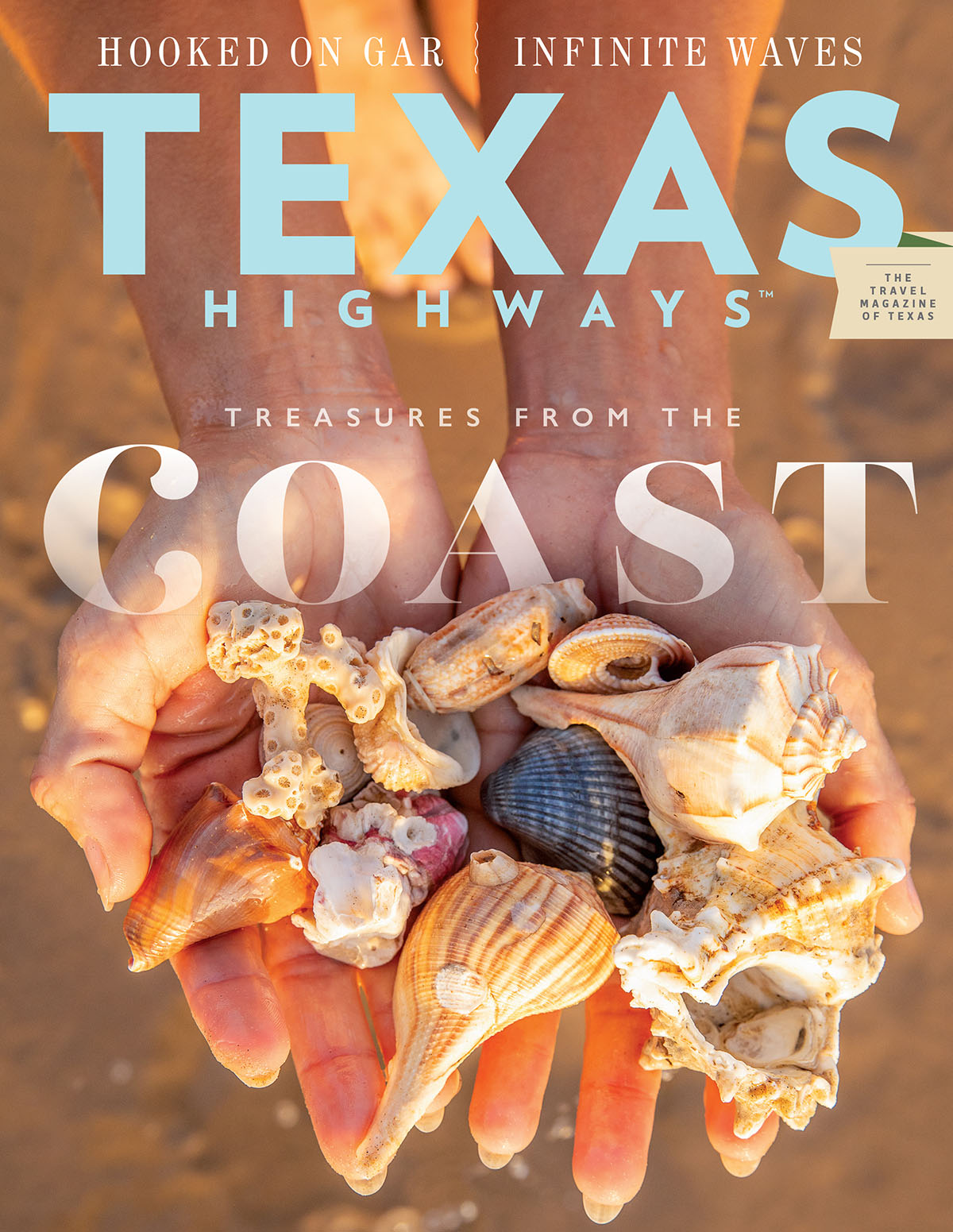
Livin’
Large
A longtime favorite in the
Rio Grande Valley, alligator
gar is a big fish that’s ready
for an even bigger stage
The sun has barely risen above the mesquite trees and carrizo cane on the high, red banks of the Arroyo Colorado when J.R. Garcia feels an aggressive tug on his line.
Illustration courtesy Texas Parks and Wildlife Department
The fight is quick as the Harlingen-based fishing guide sets the hook hard, turning the long, silver fish toward the boat. Once he hauls it aboard, Garcia carefully runs a stringer through the reptilian-looking creature’s mouth. Holdovers from the early Cretaceous period, alligator gar regularly surpass 6 feet in length and 100 pounds in weight, and this one is no different. As Garcia circles the behemoth’s thrashing 5-foot frame, he has to dodge its sharp overlapping scales and needle-like teeth.
After subduing his prey, Garcia posts a photo on his Facebook page, and almost immediately, celebratory comments start rolling in from hungry friends. Considering alligator gar’s less-than-stellar reputation in much of the state—with many dismissing it as a “trash fish”—this kind of reception might seem unusual or even sardonic. But not in the Rio Grande Valley, where the creature is highly sought after. That’s because underneath those hard scales is dense, snowy white meat that can be broken down, dipped into an egg wash, and deep-fried into the Valley favorite, chicharrones de catán.
“Down here in the Valley, it’s like a delicacy,” Garcia says. “Everybody wants it.”
While trophy anglers often target alligator gar, it is rarely eaten outside the Valley. Once an integral food source for Indigenous people in the Americas, it remains a culturally important comestible in parts of Mexico and the southernmost slice of Texas. Near the border, alligator gar’s popularity goes back generations, with locals like Garcia still frequenting fishing holes discovered by his forebears.
In communities where fresh fish wasn’t available commercially, Lenten meals were limited to canned seafood and fish from the Valley’s many waterways. The massive catán was a logical source of protein. Today, alligator gar can be found on menus as far away as Laredo and Houston, but its nexus remains the RGV and restaurants like McAllen’s Villa del Mar, which started serving chicharrones de catán at its original location in Reynosa, Mexico, in the 1980s.
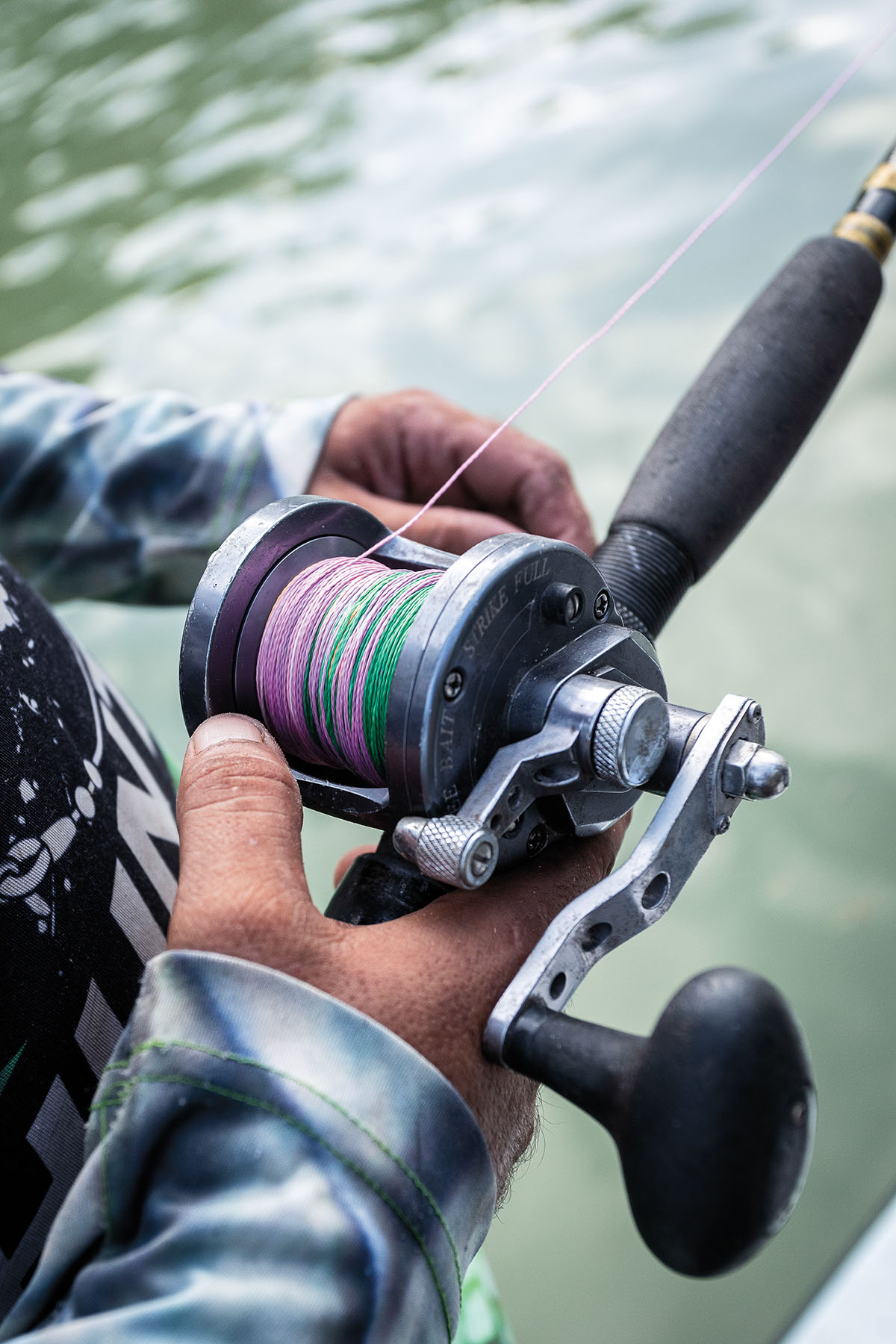
Harlingen-based fishing guide J.R. Garcia reels in an alligator gar.
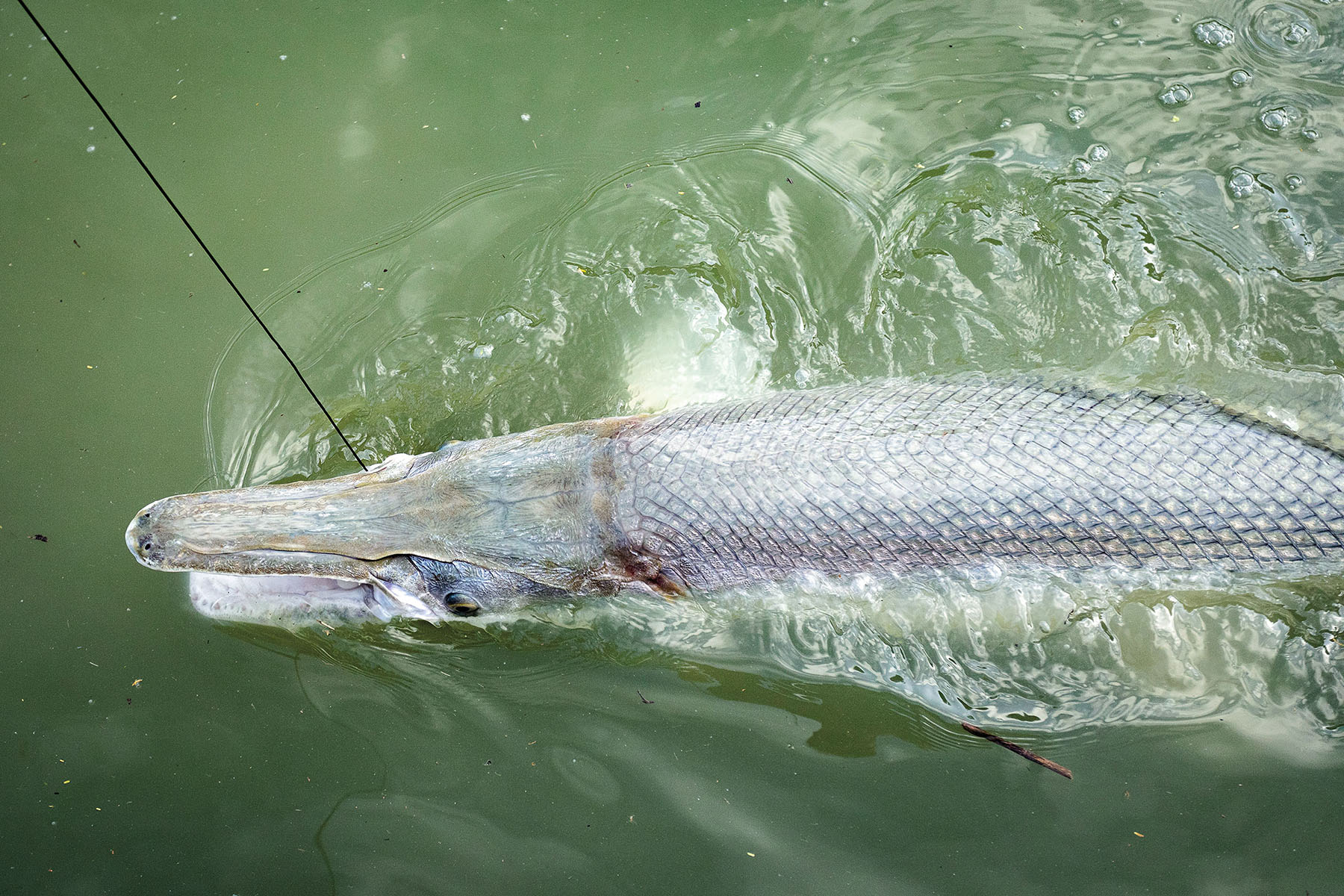
A fresh 5-foot catch
After hauling his boat out of the Arroyo Colorado on that steamy July morning, Garcia takes the catch back to his house where he uses a pair of foreceps and a machete to hack a long strip of fins and scales off the gar’s back. Using a fillet knife, he then cuts two fat loins out of the gar, which he estimates weigh 15 pounds each. He also removes and sets aside the fatty belly meat for a friend. Afterward, he heads to Chili Willie’s Bar and Grill, a seafood shack on the slow-moving Arroyo Colorado, near where it empties into the Laguna Madre. Even on a weekday, locals are gathering for burgers on their lunch break. The restaurant is known by recreational anglers as a place to cook their catch, which mainly consists of redfish and speckled trout. But there are the occasional gar enthusiasts like Garcia, who proudly hands over sacks of lightly marinated nuggets and fillets to owner Trey Mitchell.
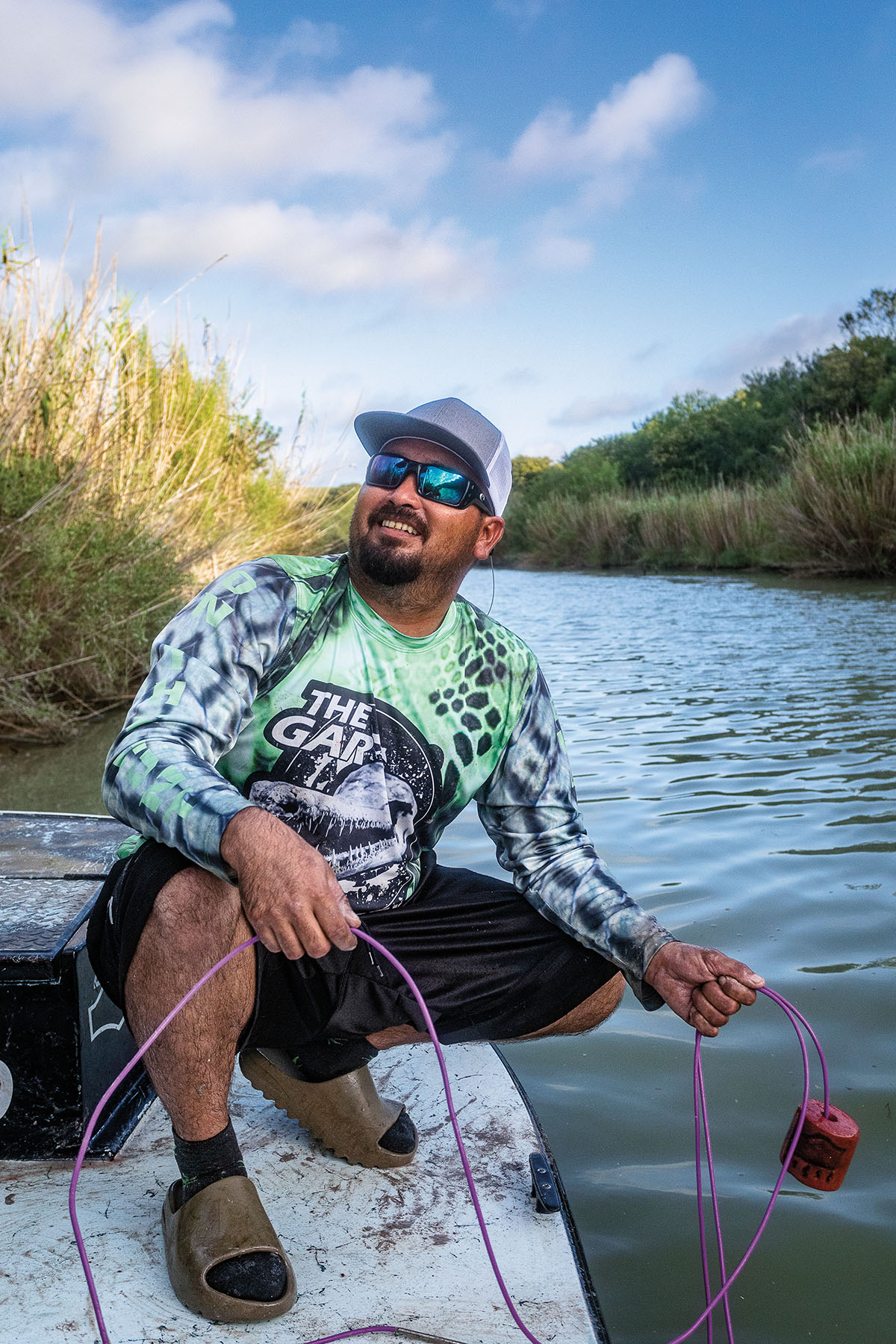
Garcia’s guiding service, The Gar Hunters, helps anglers appreciate the storied fish
While Garcia, his wife, Rosemary Hernandez, and a couple of friends wait in the dining area, they sing the praises of el catán. Two halves of a joint guiding service called The Gar Hunters, Garcia and Hernandez are proponents of sautéeing the fish in butter to make gar scampi. Mitchell prefers ceviche or cutting it into steaks for grilling. But they all agree that it tastes best as chicharrones.
A half hour later, the cooks at Chili Willie’s emerge from the kitchen brandishing heaping platters of gar fish sticks and chicharrones de catán. Even fried to a golden brown, there’s an underlying aquatic quality that closely resembles its namesake reptile: the alligator. Chefs like Aquiles Chávez of Sotero in Hidalgo, Mexico, and an original co-founder of Houston’s La Fishería, say the subtly briny flavor can prove polarizing, even to diehard seafood fans.
“You love it or you hate it,” Chávez says. “No one is in between.”
In decades past, anglers outside of the Valley would often kill alligator gar believing it was competition for more desireable fish like bass. But perceptions do change. Starting in 2009, the Texas government began taking steps to protect gar populations. And that has its champions, like Mark Villarreal—a McAllen-based fishing guide and host of the annual South Texas Alligator Gar tournament—feeling hopeful for the remarkable leviathan that patrols the rivers and resacas, oxbow lakes, and irrigation canals that crisscross the region.
“One of the reasons myself and others like to catch them is that it’s a delicious fish,” he says. “The other reason is, it’s a prehistoric fish. It’s not something everybody can say they caught and landed. Your ideal angler is always looking for a challenge, and alligator gar is just that.”
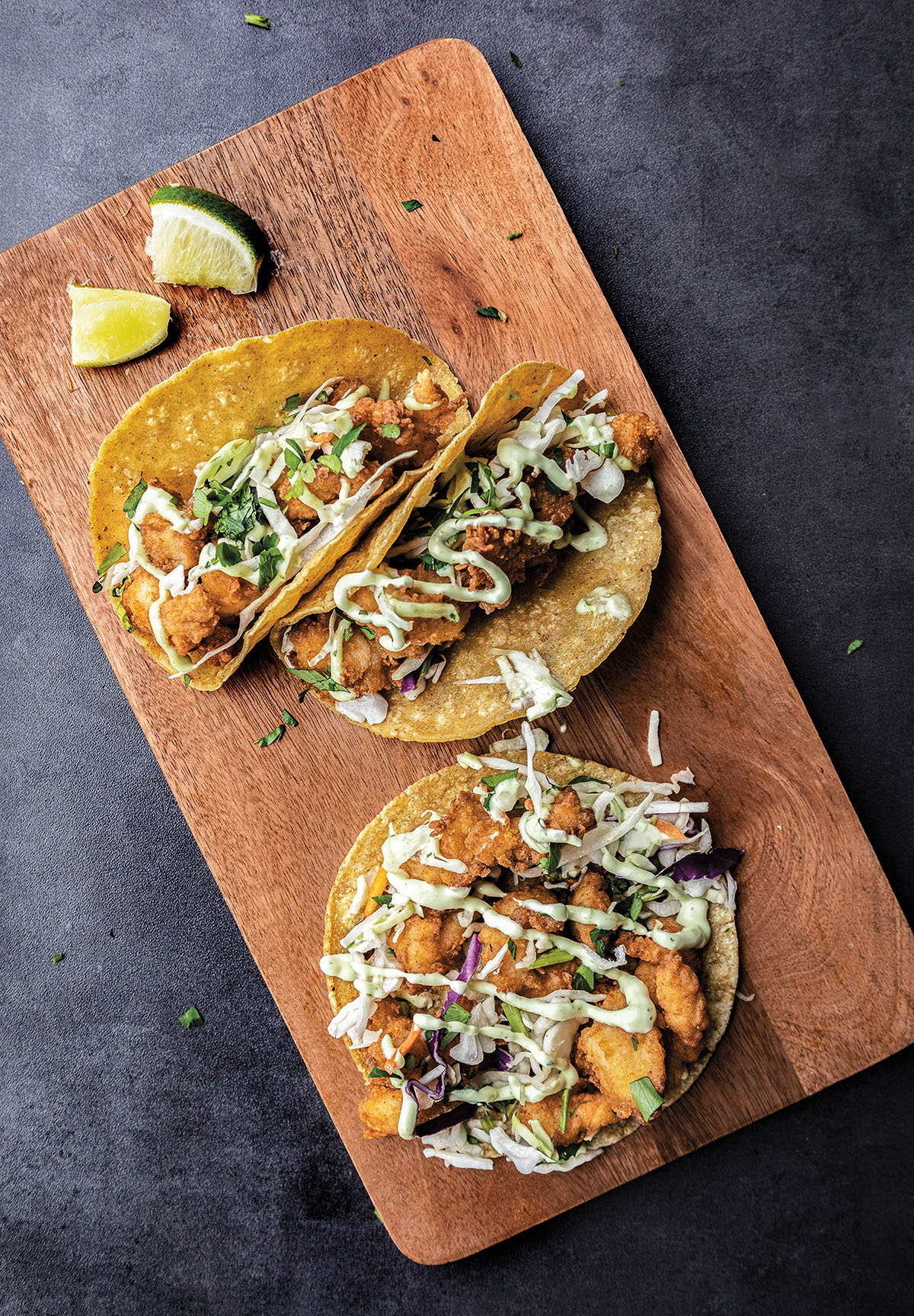
Rocha’s Bar and Grill in Laredo prepares gar several ways, including in fish tacos.
Love at First Bite
Get a taste of alligator gar at these South Texas spots
Villa del Mar
This classic northern Mexican seafood destination, now with seven locations across the RGV, bills itself as “Los Reyes del Chicharrón.”
villadelmar.us
Connie’s Seafood
Houston area
Chicharrón de catán is available by the pound at this Mexican-Asian fusion standout with multiple locations around the Houston area. conniesseafood.com
Rocha’s Bar and Grill
Laredo
Owner Rey Rocha Sr. offers fried gar on its own or in tacos accompanied by coleslaw and a rich salsa verde that’s based on the version at Laredo’s famous La Posada Hotel. rochasbarandgrill.com
The Black Pearl
Rio Grande City
Cesar Garza’s seafood restaurant outside of Rio Grande City is one of the few places where you can find Texas-caught alligator gar. The chef catches it himself on Falcon Lake.
LCD 956 Bait and Tackle
McAllen
If you’re ready to tackle the vast possibilites of cooking gar in your own kitchen, Mark Villarreal has frozen cuts for sale at his bait shop. lcd956baitandtackle.com
Their ganoid scales are only found on primitive sea creatures such as paddlefish and sturgeon. These interlocking, diamond-shaped plates are embedded with bone in the center and a harder outer layer similar to enamel. All that armor provides protection from predators, such as alligators and even larger gar, but it also weighs them down. To preserve energy, gar spend their long lives (greater than 60 years) as ambush predators. Lying in wait for a fish to swim by, they burst forward using their long, muscular bodies. For thrill-seeking anglers looking for a challenge, all that sinew helps them put up a good fight. In fact, fishing guides like Villarreal call the effect of being dragged around in a kayak by a hooked gar a “sleigh ride.”
“There are fossil records from the Permian Basin of ancestral species of alligator gar that look exactly like today’s modern alligator gar,” says Dan Daugherty, a fisheries research scientist for the Texas Parks and Wildlife Department. “They have not changed in millions of years, essentially. Given that, they’re obviously a pretty hardy fish. I mean, they’ve endured a lot of things that could wipe them out and they seem to still persist.”
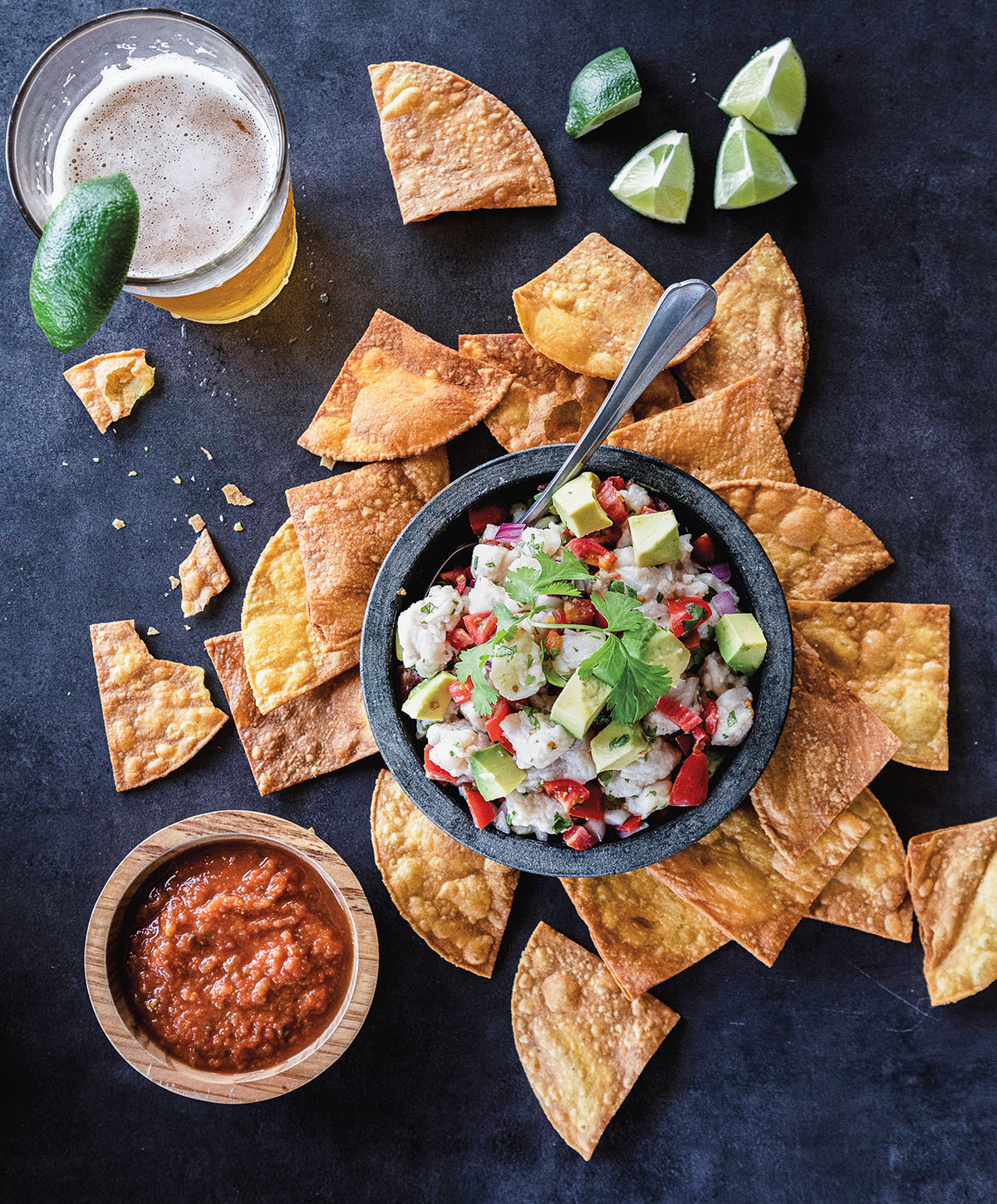
Gar fans like Trey Mitchell of Chili Willie’s Bar and Grill often use the fish in ceviche.
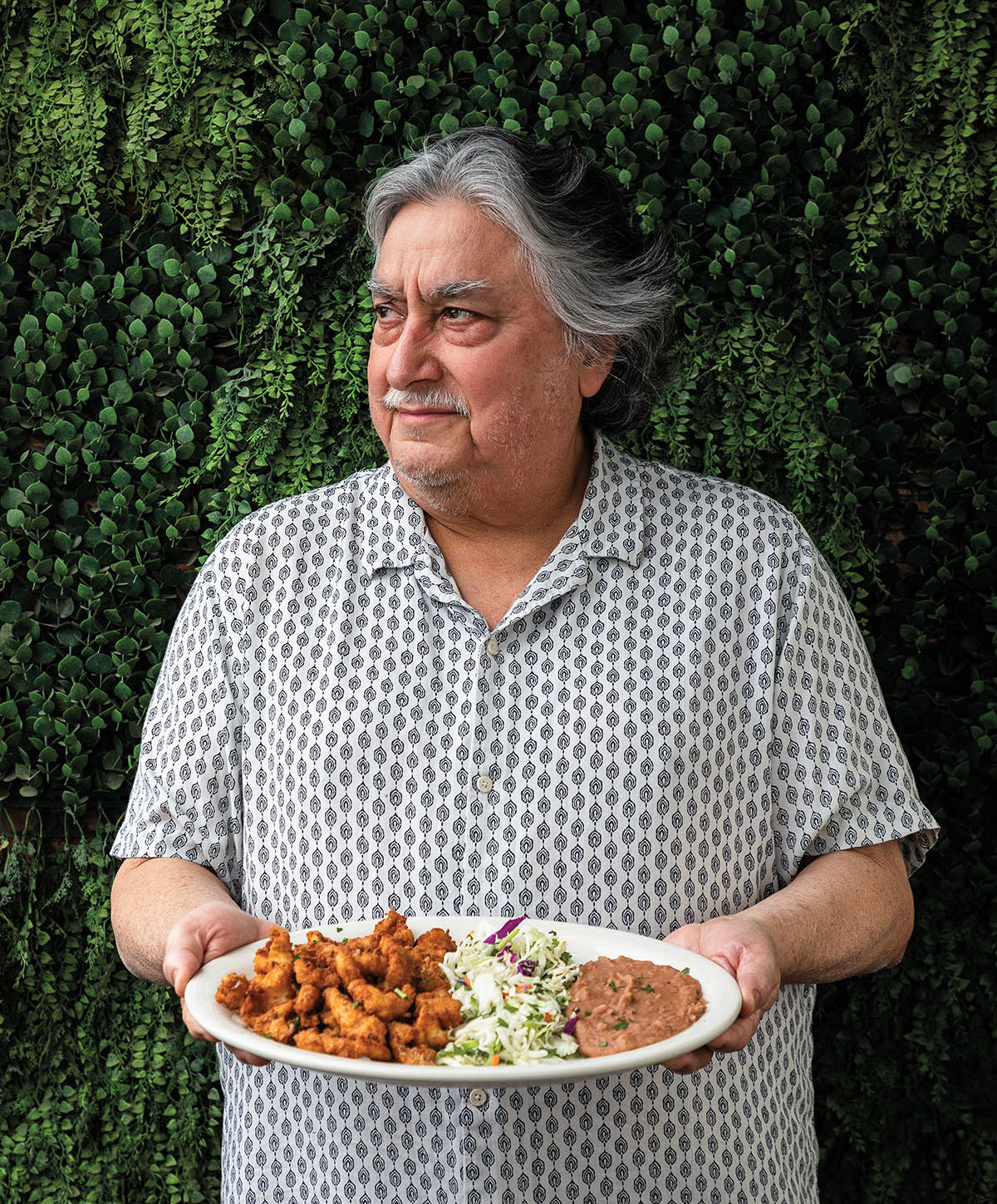
Rocha’s Bar and Grill owner Rey Rocha Sr. developed a taste for gar in his Harlingen childhood.
Today, humans remain the greatest threat to alligator gar. Because flood control dams on U.S. waterways have reduced how often rivers spill over their banks, gar have less opportunity to reproduce in the inundated floodplains they prefer during spring and summer rains. To help protect them, the TPWD began an initiative in 2009 limiting anglers to keeping one gar per day in much of the state. Since then, evidence shows the population is stable. A 2016 study of the middle Trinity River estimated a 2008 population of 8,413 alligator gar measuring 3.5 feet long or larger. Two years later, the population remained much the same: 8,365.
Fortunately for Texans, gar seem to thrive in human-made lakes with fluctuating water levels that provide them a habitat to spawn. After getting feedback from anglers and conducting a 2014 survey on Falcon Lake—a dammed portion of the Rio Grande—TPWD raised the limit there to five gar a day in 2015.
“The reservoirs have created an interesting opportunity for alligator gar,” says Mitch Nisbet, a fisheries biologist for TPWD. “At a spot like Falcon, where there’s a lot of flooded terrestrial vegetation, they’re able to do really well.”
For thousands of years before the arrival of European settlers, Indigenous people across the fish’s range—in what is now the Southern and Midwestern U.S.—ate alligator gar and used their teeth for ceremonial purposes and scales for ornaments and arrowheads. The Caddo Nation, whose lands included parts of Texas, also celebrated gar fish through a dance. Every summer, members of the Chickasaw Nation of Oklahoma still perform the nani’ kallo’ hilha’ , which translates to Hard Fish Dance. In the song, lyrics reference eating gar and using its teeth in a purification ritual.
Like other culturally significant animals, such as crawfish and white-tailed deer, alligator gar are “really treated more like people,” says Lokosh (Joshua D. Hinson), a Chickasaw linguist, artist, and cultural historian. “They’re kind of like relatives.”
Today, alligator gar has fallen out of favor as a food source in all but a few pockets of the country. Even beyond the Texas coast, most of the state approaches gar as a nuisance because the fish is so difficult to clean. Additionally, their meat is best eaten soon after they’re caught as the consistency tends to deteriorate and turn mushy. Chemicals like mercury can also accumulate in the flesh of older gar. Perhaps the most impactful factors are ingrained cultural biases, says Solomon David, an aquatic ecologist and assistant professor at the University of Minnesota. Considered a preeminent authority on gar, David says arriving European colonists in the 16th century were more likely to eat fish they recognized, such as perch and trout.
“These fish are what we’re used to eating in Europe and we see equivalents over here in the United States, so that’s what we’re going to assign value to,” David says. “Whereas these other [fish] are going to get pushed by the wayside. It depends on where you’re starting your historical perspective.”
Considering northeastern Mexico prizes chicharrones de catán as a delicacy, it’s no wonder the Valley is a domestic outlier when it comes to the perception around gar. In Tamaulipas, a state in Mexico that borders much of South Texas, there are even some efforts at alligator gar aquaculture. Livingston fishing guide Kirk Kirkland, who lived in San Benito as a teenager, learned to catch the fish and sold it to seafood wholesalers in the area. He says its popularity as a food fish amounts to a regional preference, much like catfish in the American South.
“I have clients who will take a small one home with them up to Wisconsin or wherever, and they’ll call me and say, ‘My goodness, these are so good to eat,’” he says. “I think gar has just gotten a bad name.”
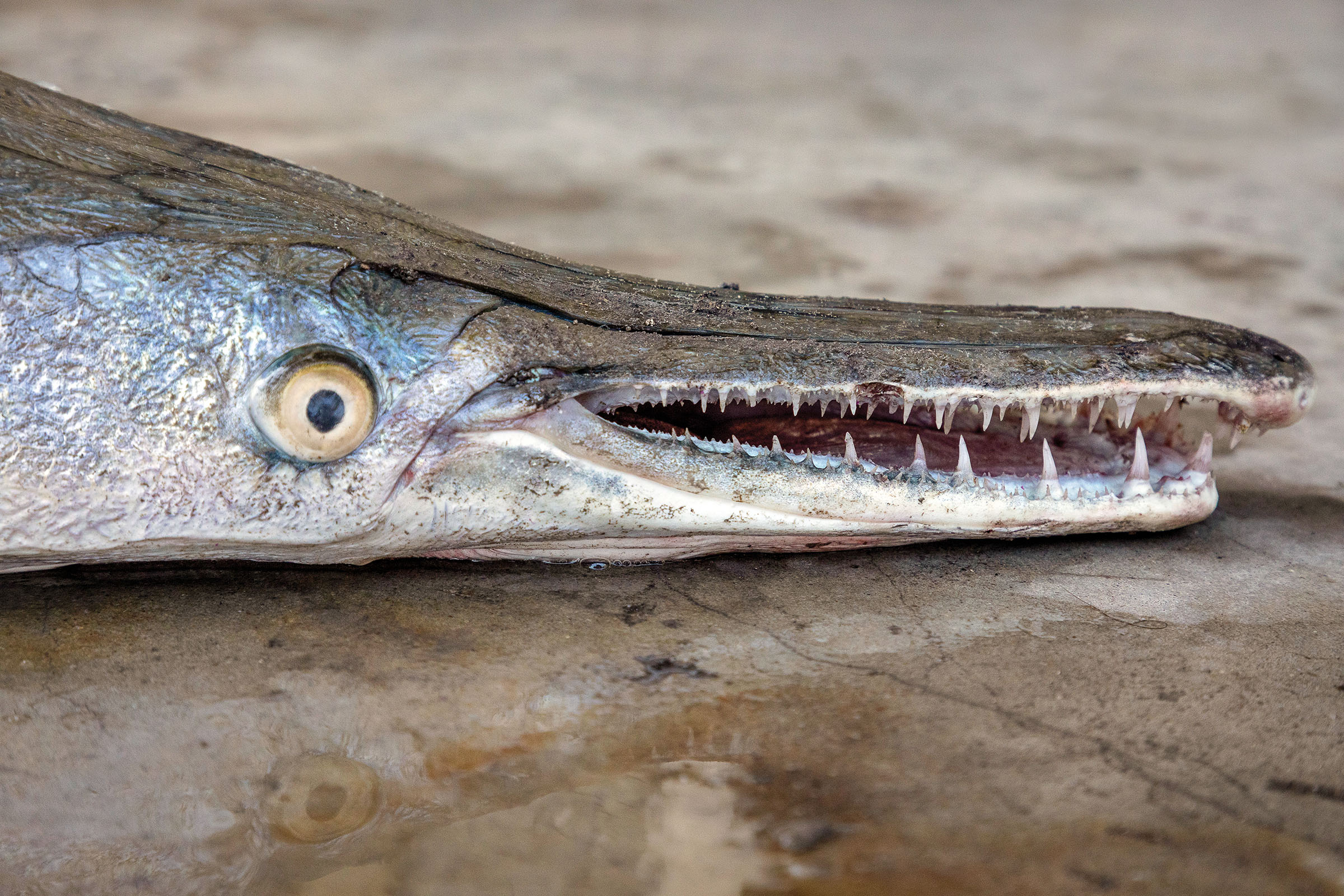
Gar have sharp teeth and an intimidating size, but don’t worry, they don’t attack humans.
The atmosphere at landlocked Rocha’s Bar and Grill in Laredo feels worlds away from the casual, saltwater-tinged scene at Chili Willie’s. Co-owner Rey Rocha Jr. circulates the dining room, where Spanish pop music trumpets over loudspeakers, and red mood lighting illuminates a well-stocked bar. On the tea light-lit patio, a pink neon sign set in a wall of climbing greenery spells out “Laretiando”—local slang for enjoying Laredo’s famed nightlife. On this evening in December, a dinner crowd mingles over guava margaritas while they peruse a menu that includes grilled rib-eyes, seafood pastas, and Tex-Mex. Even among that kind of gastronomic diversity, el catán remains the main catch for guests who have been frequenting Rocha’s for over 20 years.
“I know it’s an ugly-looking fish, but it’s excellent,” Rocha Jr. says. “Even if you don’t like fish, you’ll love this. When people were first hesitant to try it, we would give out samples. Now, people come in just for the catán.”
After launching his culinary career with a menudo restaurant, Rey’s father, Rey Rocha Sr., pivoted to a more traditional restaurant in 2005. To help his business stand out from the rest of the Laredo dining scene, Rocha Sr. delved into his past. Harkening back to his childhood in Harlingen, he remembered a bar that would cook catán in a wok-like discada over a wood fire every Friday. The smell of the frying fish would drift through their windows during Lent, tempting him to scurry down the street and bring back a brown paper bag full of the sizzling gar.
“I wanted to serve something different,” Rocha Sr. says. “And the catán just came back to me.”
Off the Hook
Local fishing guides can help you reel in your own mammoth catch
The Gar Hunters
The Harlingen-based husband-and-wife team of J.R. Garcia and Rosemary Hernandez specializes in catch and release, but they also lead anglers to Choke Canyon Reservoir and Lake Corpus Christi for those seeking trophy-size fish. facebook.com
Big Fish Bowfishing Texas
“I think bowfishing is way more action,” Houston guide Mark Malfa says. Although based in the Bayou City, Malfa travels around the state looking for the best gar fishing spots. Just a word of warning: State regulations require that gar have to be kept if taken by bow.
bigfishbowfishingtexas.com
Captain Kirk Kirkland
An early catch and release advocate, Kirkland has been in the business of leading anglers since the 1990s. After snagging 2023’s world-record gar on Sam Rayburn Reserve, the Livingston-based guide is in high demand.
alligatorgarfishing.com
Garzilla
The Trinity River is known for record-setting gar, and Cody Cryer’s team leads outdoorsmen from all over the world in their pursuits. Disembarking from Dallas to the river’s mouth on the Gulf of Mexico, the Garzilla guides counsel anglers on all kinds of rod and reel quarry.
garfish-texas.com
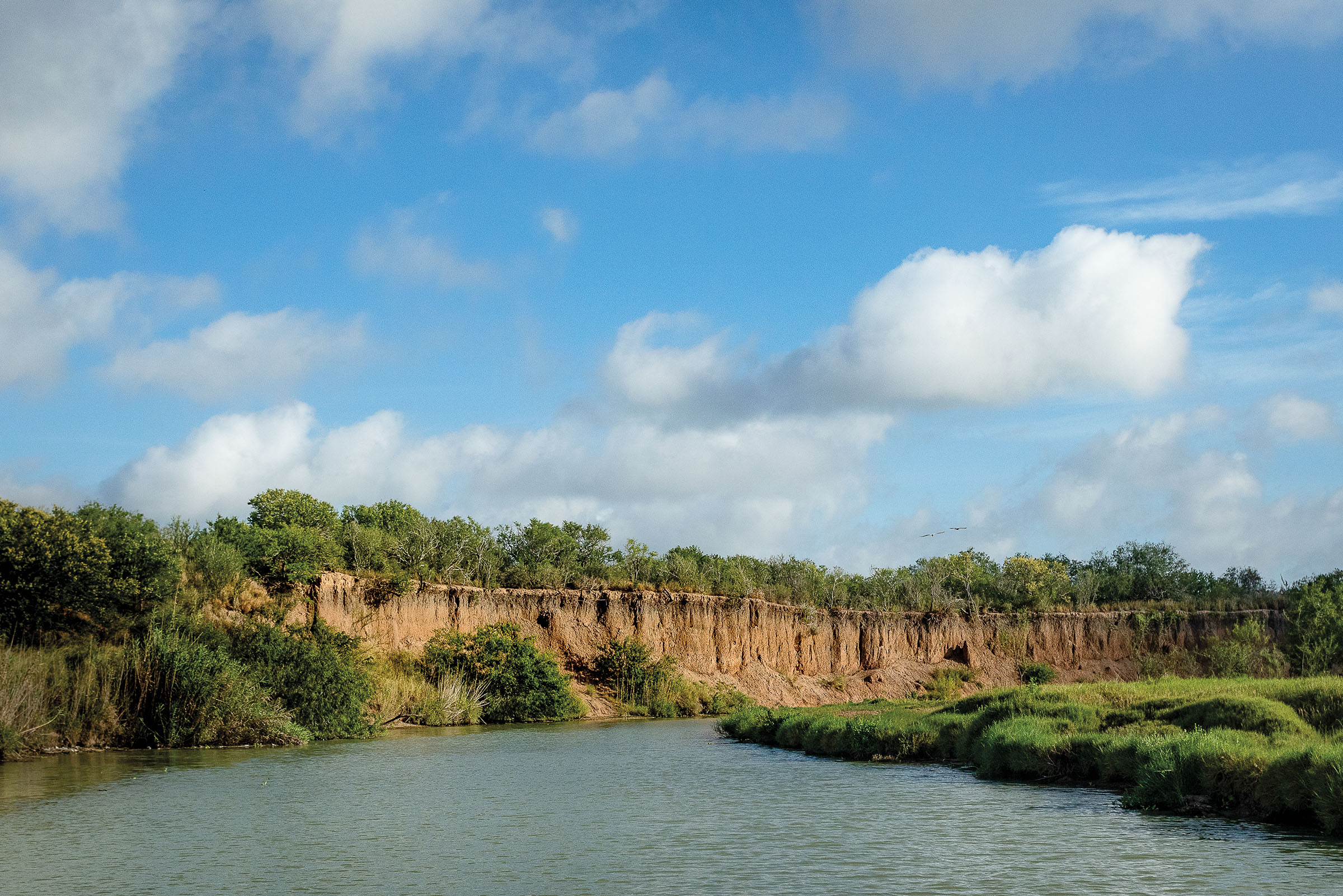
The Arroyo Colorado is a coveted fishing spot for gar.
Although sourcing the fish initially proved challenging, Rocha Sr. eventually found a wholesale supplier out of Louisiana that provided for them at its original location in downtown Laredo, as well as its current digs on the city’s north side. There, the gar is quickly marinated, dipped in a vinegar-tinged batter, and lightly fried. The result is a more tender nugget with a silken texture and a mild flavor that’s complemented by the restaurant’s habanero salsa.
A similar preparation to the chicharrones de catán common in northern Mexican states like Tamaulipas, Rocha’s version has drawn fans from both sides of the border. Chávez, who helped launch Houston’s La Fishería in 2012, first visited the Laredo restaurant while filming the television show Motochefs that same year. Now considered a premier ambassador for Mexican cuisine around the world, Chávez says he was intrigued by anyone cooking gar in a modern setting.
At his new destination restaurant in Hidalgo, Mexico, he’s now taking the ingredient even further, with offerings like gar salpicón—a shredded meat salad served over a green plantain tostón. Chávez sees the fish as having the potential to skyrocket in popularity, much like beef tongue, heritage strains of corn, and huauzontle—a bitter green related to quinoa. Can gar overcome its unusual appearance and become the darling of the culinary elite? Or even just an aquatic protein that makes the leap from working-class rations to luxury niche, like oysters in the 19th century? Chefs like Chávez seem to think so.
“Today, many young chefs cook with staples that for years were neglected or were once regarded as ‘cheap,’” Chávez says. “And suddenly, it’s being paid attention to, and it turns out, that rarity makes it cool.”
